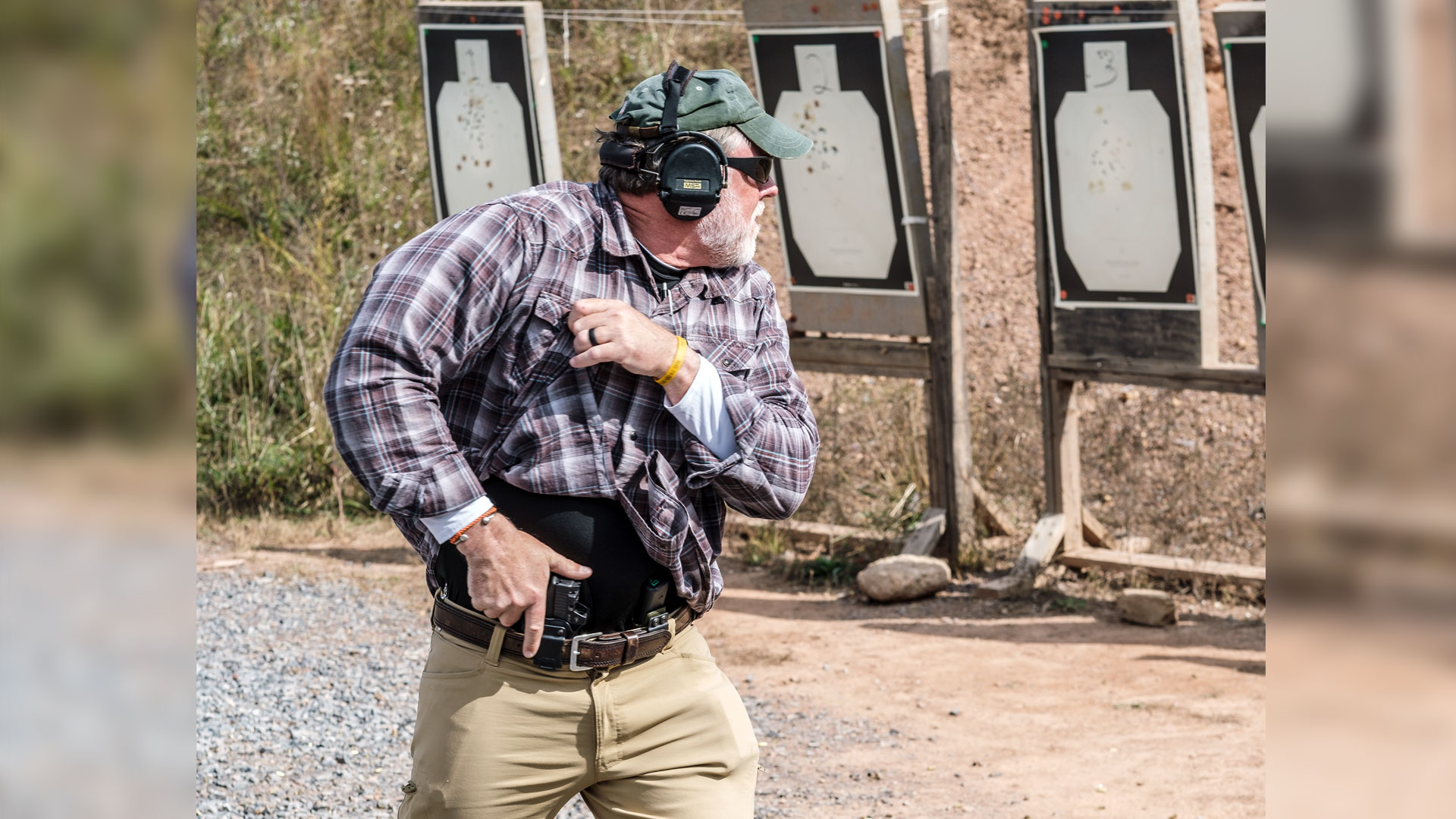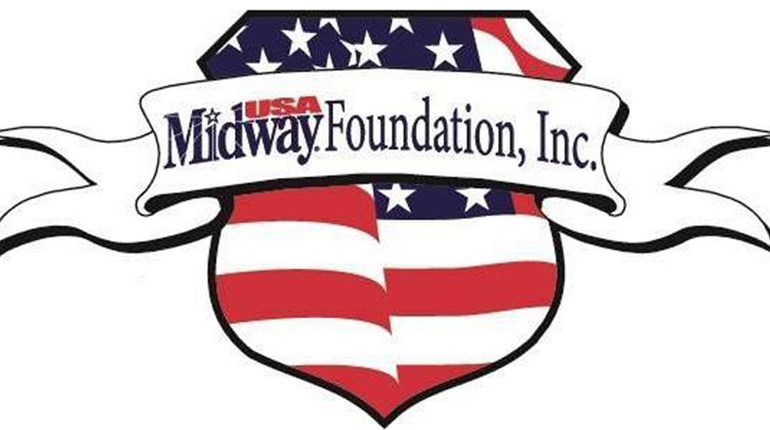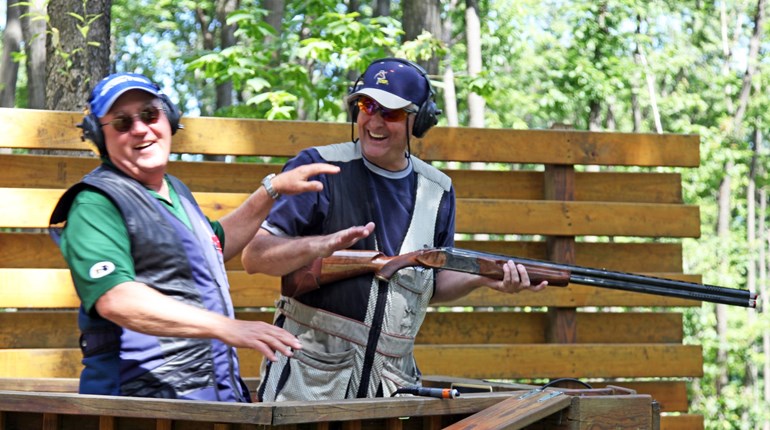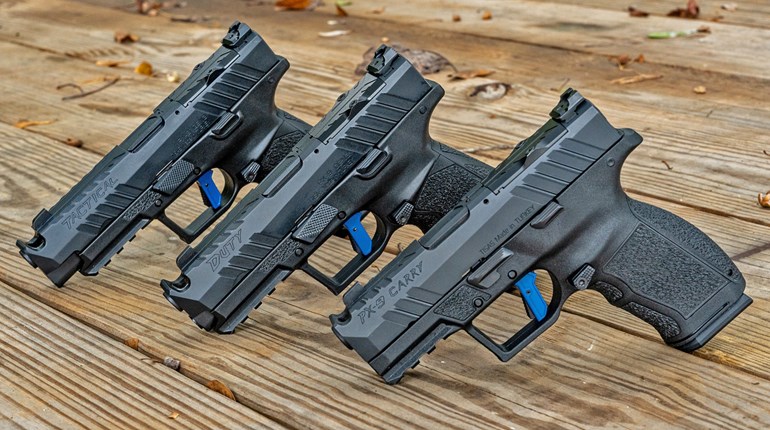
An increasingly popular shooting genre has been quietly added to the shooting world. The traditional categories of defensive shooting and competitive shooting have recently been expanded to a triumvirate including performance shooting. How does this trending category impact the other two and why is it a force to be reckoned with in the action-shooting community? The answer to this relevant question can only be ascertained with clarity of definition.

Competitive Shooting
Competitive shooting can be defined as the application of shooting in a contest or sporting environment. Any contest typically engages two or more participants. Competitions can either be informal or presented by established competition organizations like the International Practical Shooting Confederation (IPSC), the United States Practical Shooting Association (USPSA), the International Defensive Pistol Association (IDPA) and others. Local or regional shooting competitions (matches) are held at ranges throughout the country and, depending upon where you live, you almost certainly can find several nearby on a regular basis.
A typical competition consists of an array of targets set up in a certain configuration as to challenge a shooter’s depth-of-shooting skill. Targets are set up far-to-near or near-to-far with transitions left-to-right or right-to-left. Props are often used, such as fault lines, barricades, door frames, windows, steps and other similar constructs introduced as layers of complexity by which to test skill.
Steel and paper targets can include “no-shoot” targets, where points are deducted if you hit one, and varying degrees of target difficulty such as distance, size, movement, penalty, etc. A collection of target arrays on a shooting bay is called a stage, and there are usually multiple stages in a match.
At sanctioned matches, a competitive shooter may be additionally invited to shoot a posted “qualifier” to attain that organization’s ranking. Based on the shooter’s skill, they may earn class ranking such as “Class C,” “Class B,” “Class A,” “Master,” “Grand Master” and the like. Ranking is utilized to identify, group (squad) and grade shooters in a particular class based on skill level and type of firearm used.
Competitive shooting is traditionally very organized and strictly monitored by range officials. You can even find smartphone apps such as the PractiScore app providing a complete scoring system supporting several types of competitions
Defensive Shooting
Defensive shooting, or “tactical shooting” as it is sometimes referred, can be defined as the application of shooting in self-defense or operationally within a tactical environment.
Military, protective services and law-enforcement professionals are trained to varying gun-handling and shooting-skill levels and must perform in accordance with specific agency standards commonly referred to as “qualifications.”
The U.S. Department of Defense, based on the specific military branch, has set requirements for minimum-shooting-skill levels established for a service member based on their military occupational specialty (MOS). An MOS is a specific job or career field that is assigned to members of the United States Army and the United States Marine Corps. Each job is associated with a four- or three-character code, typically referred to as the MOS code. Each firearms-related MOS has a requisite firearms qualification.
The same applies for law enforcement. Every officer who carries a firearm is required to pass a state-approved peace officer standards-of-training shooting qualification.
If you are a member of a specialty team such as Special Weapons and Tactics (SWAT), you are required to pass an additional qualification as set for the members of that team, which tests those shooter’s gun-handling and marksmanship skills above and beyond that of the basic state or department qualification and is commensurate with the tasks and responsibilities of the team.
Pros, based on their specific agency policy following academy graduation, may be additionally required to attend annual in-service training designed to sustain minimal level qualification shooting skills, which are perishable without practice.
The professional tactician is trained in firearms safety, maintenance and storage per their employing agency. They are as equally well trained to appropriately utilize cover, concealment, barricades, work windows, doors, hallways, stairways, clear rooms and the like, all of which are collectively referred to as “tactics.”
Civilian shooters who carry a gun for self-defense are generally not required to pass a qualification or maintain a designated skill level and may or may not need to apply for a concealed-carry permit based on state of residence. They may also be trained in tactics at various shooting schools, in organizations and in private training.

Snub and Rub
The generalized so-called “bi-partisan shooting community” comprises predominantly competitors and tacticians (defensive shooters). A long-standing rub or “jovial rivalry” between opposite sides of the aisle loosely represents the viewpoint of each category.
The average tactician rolls their eyes at the average competitor because the latter are perceived as “tactically uneducated” and do not appropriately utilize cover, barricades, windows and other such props in their stages. As a result of this transgression of tactical standards, they are affectionately known throughout the tactical training community as “gamers”—a jocular term applied to competitors by defensive shooters.
Conversely, skill-wise, it is the perception of upper-level gamers that the average competitor can outshoot the average tactician. A competitor (again on average) can usually shoot faster and more accurately than their tactically trained counterpart and therefore will jokingly (sort of) raise their nose up at the “lower shooting skills” of a defensive shooter. As there is never a “never” and never an “always” there are, of course, always exceptions.
Although they may be more the exception than the rule, it is not all that difficult to find real-world gunfighters who possess the shooting skills rivaling that of a Master Class-ranked competitor. You can also can find legitimate competitors who are active members of the tactical community.
It is said that you can take a master-class shooter and teach them how to clear a room in a matter of weeks, but that you cannot take a tactician and turn them into a master-class shooter in the same amount of time. The truth of the matter is that just a few weeks is not enough time to appropriately develop either to a functional level of operational proficiency.
Regardless of the camp with which you may align, the bottom line is shooting is shooting. You either have the shooting skills or you do not.
If you’re a gamer, when you hear that shot timer (aka buzzer—the “go” signal) it gives you permission to reach for your firearm. If you’re a tactician or defensive shooter, and you have identified a clear and present danger (an active threat) warranting lethal use of force where there are no other options but to employ your firearm as a life-saving tool, then you must make the “shoot” or “no-shoot” decision. Once the life-saving decision is made to shoot, then you have no other choice but to commence the shooting process.
Whether you train to compete or train for self-defense, once the “shoot” decision is made, you move to engage your shooting skills. The gamer is trying to win a match and, in some cases, put food on the table. The self-defense shooter is trying to save their very life or that of another. Either way, the situation demands that you fully rely on your current training level for success.

Performance Shooting
Multi world-champion and master shooting instructor Rob Leatham is one of the original founding fathers of what is currently called performance shooting. In his own words “Performance shooting is about learning how to shoot well.” Leatham states that its foundation is derived from a level of understanding about shooting and that skill can only be developed from that understanding. The order of process is: level of understanding followed by skills development followed by your ability to perform that skill.
Performance shooting can be defined as the ability to demonstrate your shooting skills on demand. It means how well you can shoot regardless of application, be it competition or defense.
Top-tier performance-shooting instructors dominate the current performance-training industry. The advent of this growing genre has produced a significant uptick in class attendance for the likes of popular shooting performance instructors (listed in alphabetical order) such as Mike Green (Green Ops), Tim Herron, Scott Jedlinski (Modern Samurai Project), Doug Koenig, Ernest Langdon, Rob Leatham (Leatham Enterprises), Travis McCamish (Hat Creek Training), Max Michel (SIG Sauer Academy), Mike Pannone (CTT Solutions), Matt Pranka (Xray Alpha), Frank Proctor, JJ Racaza, Bill Rogers (Reactive Shooting), Mike Seeklander, Gabe White, A.J. Zito and many others.
Training dollars spent on the development of performance-shooting skills go not only toward instructor fees, but also toward purchasing firearms, ammunition and gear. It’s an arena where a predominantly younger demographic prevails and is a mandatory gateway that leads to the growing and increasingly competitive world of shooting competitions, with considerable crossover to the practical defensive (tactical) shooting world.
Performance shooting is now a training staple of the U.S. Special Forces community, where select units require senior shooting staff to be at least a master-class-ranked shooter just for eligibility to apply for a primary firearms instructor (PFI) position.

Behind the Curtain
A quick peek behind the curtain reveals some of performance shooting’s guiding principles. One overriding percept is that other than safety, there are no rules, no ceiling and no limitations placed on the shooter, such as a maximum qualification score.
The performance bar is a perpetually upward moving target, and there are no limits other than those restrictions that a shooter may place upon themselves. Performance shooters are encouraged to train with as many other instructors, schools and systems as possible to gain multiple perspectives.
Performance shooting is learning how to shoot very well—way above and beyond the level of a “good shooter”—or meeting the highest attainable score on an agency qualification. It is about depth of shooting and developing far-reaching skills well outside your comfort zone. It is about achieving success with extremely challenging, but attainable goals.
Speed and accuracy are considered measurements of shooting efficiency. You would be hard pressed to find such arbitrary terms as “fast” or “slow” and more likely to hear such terminology as “urgent” and “careful.”
Defensive shooting, or “tactical shooting” as it is sometimes referred, can be defined as the application of shooting in self-defense or operationally within a tactical environment.
Make no mistake, performance shooters are held to the highest levels of accountability (time and accuracy). However, the entire premise of performance shooting is not based on those results (time and accuracy), but rather on the actual shooting process itself. The byword of performance shooting is efficiency. Any wasted movement (unnecessary input to the shooting process) costs you both time and accuracy.
Skill deficiencies are identified, isolated and then broken down into their sub-component parts and rigorously drilled one sub-component at a time. After measurable success, two of those subcomponents are run together and then three and so on until the complete skill is rebuilt to a point where it is repeatable, on demand, greater than 80 percent of the time.
Performance shooting is 100-percent shooter-based. It doesn’t follow any set doctrine, charter or pre-set programming. It’s all about the learning pace, discipline, commitment and motivation of the shooter.
In the world of performance shooting, you can’t fix what you can’t see, so shooting diagnostics are paramount to skills development and are based squarely on honest, unfiltered observation. Most drill sequences are based on the mechanical (physical) and subconscious (mental) aptitude of the shooter. For example, you would run a specific drill to 80 percent repeatability and then push it to either faster (speed) or farther (increase distance) with an accuracy accountability until the wheels fall off because of the difficulty level at which point it teaches you what to work on next.
In that same world of performance, there’s no such thing as “generous times,” and the better you get, the tougher the requirements. At the entry levels you can make measurable gains in shorter periods of time. However, the higher your skill level and confidence ascends, the exponentially longer it takes to attain the next level.
At the upper performance levels, the requirement is to be able to perform on demand better than 80 to 85 percent of the time. All performance must be repeatable. Yes, you may be able to catch lightning in a bottle once in a great while, but if you can’t perform that same shooting skill four out of five times in a row, you have not yet earned that skill level.
The ultimate definition of performance is you can do it (whatever the task) on demand with no mistakes 80 to 85 percent of the time.
Shooting performance also offers specialization, such as red-dot systems (RDS), revolver, precision rifle et al. As the demand for performance shooting continues its meteoric rise, so will the supply for that demand.
Outside the Box
The norm for most professional agencies is to bring their trainees to a certain approved skill level based on qualification. If you are an employee of that agency and you want to shoot past its qualifications’ highest possible score, then the onus is on you to step outside that box and seek outside training on your own time and your own dime.
Even though there may not be qualifications per se in performance shooting, there are a number of shooting-performance industry standards out there such as the MSP Black Belt, the Fast Coin, Turbo Drills (Gabe White), the Wilson 5x5, the Roger’s System Gold Coin and many others. Although attainable, they can be quite difficult to achieve for even an accomplished shooter as they are designed to challenge the likes of an A-Class-/Master-level shooter or better.
Performance shooting has risen to such a prominence that the waiting list to get in certain classes gets longer every year. For example, Modern Samurai Project’s RDS courses are booked well into next year, and the annual Max Michel Pro Shooter Experience performance training course fills in less than a matter of hours with next availability in the following year.
The benefits of performance shooting span the gamut from readily measurable to remarkable. Police officers involved in real-world gunfights have benefited tremendously from performance shooting where, because of their surplus skill and confidence, more of their attention was freed up to read, process and make educated decisions to prevail in a deadly tactical scenario.
The entire purpose of performance shooting is to make you a better shooter by developing efficiency and taking your overall on-demand shooting skills to the next level. If you’re a serious student of the gun, regardless of whether you apply your skills tactically, competitively or both, why wouldn’t you want to perform at a world-class level?
Shooting performance, like the journey of life itself, is a long and never-ending winding road rife with both infuriating frustration and pulse-quickening success. Its irreproachable value is acknowledged by military and law enforcement specialty teams worldwide as the pros are inexorably drawn to its reliability and sustainability. As such, performance shooting makes both the competitor and the defensive shooter alike a most formidable force with which to be reckoned.





































